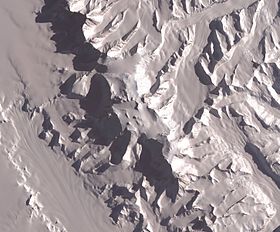| Vinson Massif | |
|---|---|
 Mount Vinson at Vinson Plateau | |
| Highest point | |
| Elevation | 4,892 m (16,050 ft)[1] |
| Prominence | 4,892 m (16,050 ft)[2] Ranked 8th |
| Listing | Seven summits Ultra |
| Coordinates | 78°31′32″S 85°37′2″W / 78.52556°S 85.61722°W[3] |
| Geography | |
| Parent range | Sentinel Range |
| Climbing | |
| First ascent | 1966 by Nicholas Clinch and party |
| Easiest route | snow/ice climb |


Vinson Massif (/ˈvɪnsən mæˈsiːf/) is a large mountain massif in Antarctica that is 21 km (13 mi) long and 13 km (8 mi) wide and lies within the Sentinel Range of the Ellsworth Mountains. It overlooks the Ronne Ice Shelf near the base of the Antarctic Peninsula. The massif is located about 1,200 kilometres (750 mi) from the South Pole. Vinson Massif was discovered in January 1958 by U.S. Navy aircraft. In 1961, the Vinson Massif was named by the Advisory Committee on Antarctic Names (US-ACAN), after Carl G. Vinson, United States congressman from the state of Georgia, for his support for Antarctic exploration. On November 1, 2006, US-ACAN declared Mount Vinson and Vinson Massif to be separate entities.[4][5] Vinson Massif lies within the unrecognised Chilean claim under the Antarctic Treaty System.
Mount Vinson is the highest peak in Antarctica, at 4,892 metres (16,050 ft).[6] It lies in the north part of Vinson Massif's summit plateau in the south portion of the main ridge of the Sentinel Range about 2 kilometres (1+1⁄4 mi) north of Hollister Peak.[5] It was first climbed in 1966 by an American team led by Nicholas Clinch. An expedition in 2001 was the first to climb via the Eastern route, and also took GPS measurements of the height of the peak.[7] As of February 2010, 1,400 climbers have attempted to reach the summit of Mount Vinson.[8] Mount Vinson is ranked 6th by topographic isolation.
- ^ "Vinson Massif" Archived 8 September 2016 at the Wayback Machine Peakbagger.com. Retrieved 2011-10-26.
- ^ "Antarctica – Ultra Prominences" Archived 4 March 2016 at the Wayback Machine peaklist.org. Retrieved 2011-10-26.
- ^ Cite error: The named reference
wpwas invoked but never defined (see the help page). - ^ Cite error: The named reference
gniswas invoked but never defined (see the help page). - ^ a b Stewart, J. (2011) Antarctic An Encyclopedia McFarland & Company Inc, New York. 1776 pp. ISBN 9780786435906.
- ^ Antarctica. In The Kingfisher Children's Encyclopedia. New York, New York: Kingfisher. 2012. p. 16.
- ^ Cite error: The named reference
novawas invoked but never defined (see the help page). - ^ Cite error: The named reference
7summitswas invoked but never defined (see the help page).
